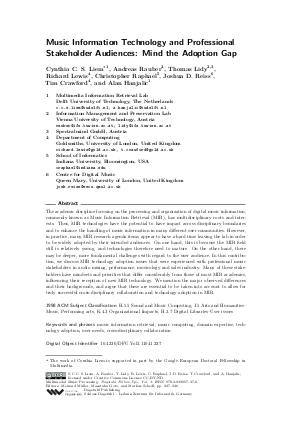Music Information Technology and Professional Stakeholder Audiences: Mind the Adoption Gap
Authors Cynthia C.S. Liem, Andreas Rauber, Thomas Lidy, Richard Lewis, Christopher Raphael, Joshua D. Reiss, Tim Crawford, Alan Hanjalic
-
Part of:
Volume:
Multimodal Music Processing (DFU - Vol. 3)
Part of: Series: Dagstuhl Follow-Ups (DFU) - License:
 Creative Commons Attribution 3.0 Unported license
Creative Commons Attribution 3.0 Unported license
- Publication Date: 2012-04-27
File

PDF
DFU.Vol3.11041.227.pdf
- Filesize: 449 kB
- 20 pages
Document Identifiers
Subject Classification
Keywords
- music information retrieval
- music computing
- domain expertise
- technology adoption
- user needs
- cross-disciplinary collaboration
Metrics
- Access Statistics
-
Total Accesses (updated on a weekly basis)
0Document
0Metadata
Abstract
The academic discipline focusing on the processing and organization of digital music information, commonly known as Music Information Retrieval (MIR), has multidisciplinary roots and interests. Thus, MIR technologies have the potential to have impact across disciplinary boundaries and to enhance the handling of music information in many different user communities. However, in practice, many MIR research agenda items appear to have a hard time leaving the lab in order to be widely adopted by their intended audiences. On one hand, this is because the MIR field still is relatively young, and technologies therefore need to mature. On the other hand, there may be deeper, more fundamental challenges with regard to the user audience. In this contribution, we discuss MIR technology adoption issues that were experienced with professional music stakeholders in audio mixing, performance, musicology and sales industry. Many of these stakeholders have mindsets and priorities that differ considerably from those of most MIR academics, influencing their reception of new MIR technology. We mention the major observed differences and their backgrounds, and argue that these are essential to be taken into account to allow for truly successful cross-disciplinary collaboration and technology adoption in MIR.
Cite As Get BibTex
Cynthia C.S. Liem, Andreas Rauber, Thomas Lidy, Richard Lewis, Christopher Raphael, Joshua D. Reiss, Tim Crawford, and Alan Hanjalic. Music Information Technology and Professional Stakeholder Audiences: Mind the Adoption Gap. In Multimodal Music Processing. Dagstuhl Follow-Ups, Volume 3, pp. 227-246, Schloss Dagstuhl – Leibniz-Zentrum für Informatik (2012)
https://doi.org/10.4230/DFU.Vol3.11041.227
BibTex
@InCollection{liem_et_al:DFU.Vol3.11041.227,
author = {Liem, Cynthia C.S. and Rauber, Andreas and Lidy, Thomas and Lewis, Richard and Raphael, Christopher and Reiss, Joshua D. and Crawford, Tim and Hanjalic, Alan},
title = {{Music Information Technology and Professional Stakeholder Audiences: Mind the Adoption Gap}},
booktitle = {Multimodal Music Processing},
pages = {227--246},
series = {Dagstuhl Follow-Ups},
ISBN = {978-3-939897-37-8},
ISSN = {1868-8977},
year = {2012},
volume = {3},
editor = {M\"{u}ller, Meinard and Goto, Masataka and Schedl, Markus},
publisher = {Schloss Dagstuhl -- Leibniz-Zentrum f{\"u}r Informatik},
address = {Dagstuhl, Germany},
URL = {https://drops.dagstuhl.de/entities/document/10.4230/DFU.Vol3.11041.227},
URN = {urn:nbn:de:0030-drops-34759},
doi = {10.4230/DFU.Vol3.11041.227},
annote = {Keywords: music information retrieval, music computing, domain expertise, technology adoption, user needs, cross-disciplinary collaboration}
}
